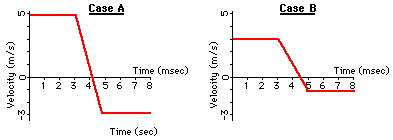velocity
What is the momentum of a 60-kg halfback moving eastward at 9 m/s.
540 kg•m/s, east

Which of Newton's Laws does this represent?
Newton's 3rd Law
________ is a change in momentum.
impulse
The momentum equation shows that momentum is ___________ proportional to an object's mass.
directly
Momentum of a 1000-kg car moving northward at 20 m/s.
20 000 kg•m/s, north
True/False
For any collision occurring in an isolated system, momentum is conserved.
true

Which case has the greatest velocity change?
Case B
The velocity changes from +30 m/s to -28 m/s. This is a change of 58 m/s (-) and is greater than in case A (-15 m/s).
True/False
An object's momentum is indirectly proportional to an object's velocity
false
A car possesses 20 000 units of momentum. What would be the car's new momentum if the velocity doubled?
40,000 units of momentum
A large truck collides with a small bicycle.
Which vehicle experiences the greatest force of impact?
both have the same

Which case has the biggest momentum change?
case B,
momentum change depends on velocity change
kg x m/s
A car possesses 20 000 units of momentum. What would be the car's new momentum if its mass was doubled (by adding more passengers),
40,000 units of momentum
A large truck collides with a small bicycle.
Which vehicle experiences the largest impulse?
both have the same impulse

Which case has the greatest acceleration change?
case A
Momentum is a ______________ quantity with both magnitude and direction.
vector
A 60 kg quarterback is running at 3 m/s down the field.
A 90 kg halfback is running at 2 m/s down the field.
Which player has the most momentum?
neither, both players have the same momentum.
A large truck collides with a small bicycle.
Which vehicle experiences the largest acceleration?
The bicycle
F1=F2
F=ma
Bicycle's mass is smaller so acceleration must be greater

Which case has the greatest impulse?
Case A
impulse = momentum change, which depends on velocity change and velocity change is greatest in case A